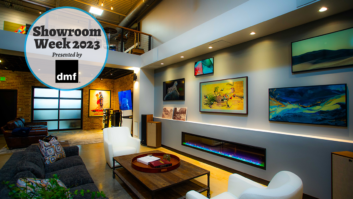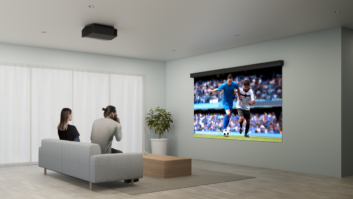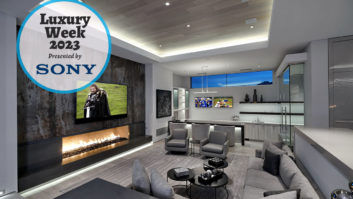You may believe that the rooms you design sound very good, but unless you consider all of the technical variables for your system, you will never know how much better they could sound.
Speakers & Subwoofers
Lets begin with choosing loudspeakers and work backwards up the signal path. Theres a lot here that you should have already figured out for yourself. Im talking about things like size, look, price, etc. There is also a list of technical criteria that many of you may not even know exists. It applies to both front and surround speakers, but with differing requirements.
First is directivity, which is the ratio of sound a speaker radiates on-axis vs. spherically. In short, directivity tells you how focused or spacious a speaker will sound, how clearly it will reproduce dialog, and how precisely it will image. Rarely will consumer manufacturers publish the directivity index (DI) of their speakers, so heres a chance to show your quality and aggressively pursue them until they do. Once you get the data, go with a DI of 7dB from 500 Hz to 10 kHz in medium-sized rooms and 9dB in larger rooms.
Second is the sound pressure level a speaker will produce. Start by looking for a sensitivity specification. Ideally, it will be given as a number of dB at 2.83 volts and 1 meter. You may find 1 watt/1 meter instead, but that only works if the speaker is 8 ohms. Subtract 7dB from the sensitivity to find out how loud the speaker will play at typical listening distances in a 3,000 ft.3 room. For twice the room volume, subtract 3dB more. For half the volume, subtract 3dB less, etc.
Unfortunately, sensitivity doesnt tell the whole tale. You also need to know a speakers power handling and maximum excursion. Power handling is a long-term average measurement, in watts, of the power a speaker will take before the voice coils melt. Speaker manufacturers are required to specify it for safety reasons and fairness to consumers. Excursion, on the other hand, is a measurement of maximum short-term output on brief dynamic peaks before a speaker goes into massive break-up. Manufacturers will likely not specify it and probably dont know it. Try asking them, and keep asking until you get results.
So how do you figure out if a speaker will play loud enough for your application? Say, for example, you want each main channel to produce a cinema reference level of 105dB. Take a 92dB/2.83 V/1 m speaker in a 3,000 ft.3 room, and subtract 7dB to reach 85dB at the seats. To get to 105dB, the speaker must handle 28 V, or 100 watts. A 6,000 Ft.3 room requires 3dB more, or 200 watts.
Third is sound quality. Much passion has gone into quantifying the sound quality of speakers, and many experts still disagree. There are some knowns, though. If a speakers axial frequency response, which is measured at one point directly in front of the speaker, looks like an accident, then throw that speaker out. Not all listeners are on-axis, though, so also consider the average response across 15 degrees vertical and 30 degrees horizontal. This oblong cone is called the listening window. The response should be smooth, but not necessarily perfectly flat. Finally, look at sound power, or the net energy a speaker radiates in all directions. It remains one of the best indicators of how a speaker will actually sound in-room, but still very few manufacturers publish it. Start making some calls. Sound power will typically curve down slowly from bass to midrange, then flatten out through the midrange to highs. What you dont want to see are peaks and valleys.
One additional component of sound quality is distortion. Less than one percent is fine; its almost pointless to go really low because human hearing isnt that sensitive. Definitely avoid speakers with distortion above three percent, which is clearly audible.
Fourth is the impedance curve, which represents how hard a speaker is for an amplifier to drive. Stay away from impedance curves that dip below 3 ohms. There should be no wild up or down swings in the impedance at various frequencies, either. The combination of low impedance and big swings makes a speaker tough on amplifiers. Distortions are likely to creep in, and amplifiers may even heat up and go into thermal shutdown. Like directivity and sound power, impedance curves are rarely specified, but they are nonetheless important. Stick to manufacturers who provide them.
Now, for the question of the day. Does a speaker that meets all the above criteria actually sound good to your ears? We pretty much all agree that its unadvisable to pick a speaker based solely on objective measurements, but you should absolutely use measurements to shorten the list of contenders. Once youve found several speakers that measure up, listen to them and pick the one you like. Remember…if it doesnt meet all the technical criteria, it cant really sound good.
Subwoofers are an entirely different breed of cat, and I lack the space here to go into detail. However, you can look back at the November 2004 column (www.resmagonline.com) for more information.
Amplifiers
Essentially, amplifiers should be big enough and stable enough in a variety of impedances to drive the speakers to the requisite SPL. Aside from that, some amplifiers have featuresbalanced inputs, triggers, overload indicatorsthat may make them more useful to you. Keep these in mind when youre choosing the one for you.
Equalizers
After doing hundreds of systems with equalizers, I can personally allay fears about their sound quality. Even golden-eared recording engineers now mix on equalized monitors. When selecting equalizers, go digital and parametric, preferably 24 bit and 12 band. You may also want equalizers that support presets for different modes like extended bass or accentuated surround. Limiters come in handy, too, to protect against overzealous teenagers eager to impress friends.
AV Controllers
What should be the deciding factor in the AV controller you choose for a job? It must do everything you need it to do! Believe it or not, the core signal processing in most AV controllers is close to the same, because similar chips are used. Digital-to-analog converters and analog circuitry are the big difference-makers in sound quality. More important even than that, usually, is the quality and scope of the speaker system adjustment process and the actual number and type of inputs. Does a controller have adequate settings for bass management, speaker delays, and levels? Will it accept and decode every audio format you send it, and output the signal you need to feed the equalizers? After those questions are answered, consider how reliable it is. AV controllers are basically computers and have the same propensity to lock up. Lastly, think about the future and how easy the controller is to upgrade, both hardware and software.
Anthony Grimani (agrimani@ pmiltd.com) is president of Performance Media Industries, a California-based acoustical engineering firm specializing in home theater design and calibration.
Chase Walton contributed to this article.







